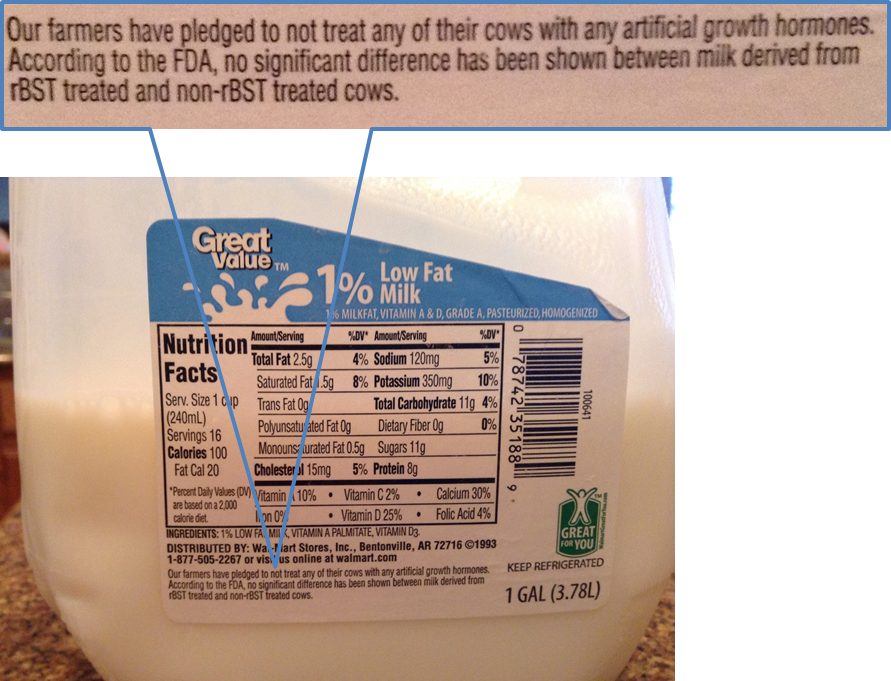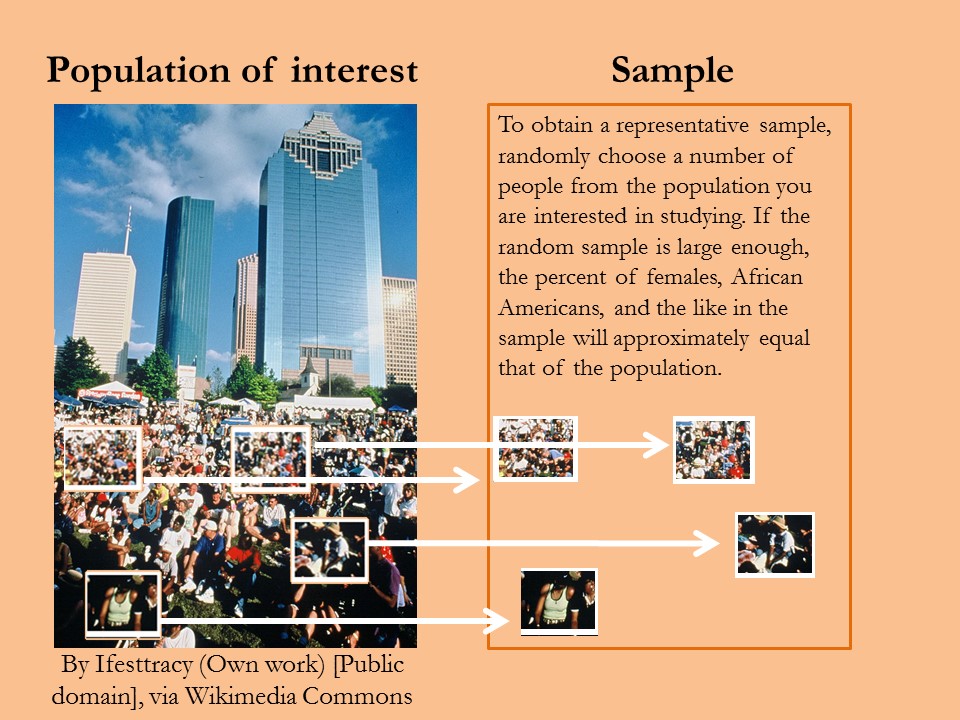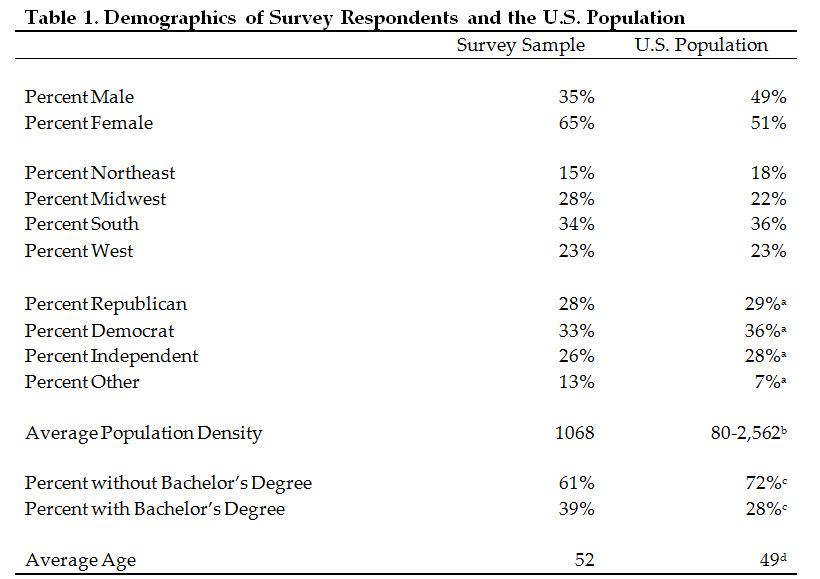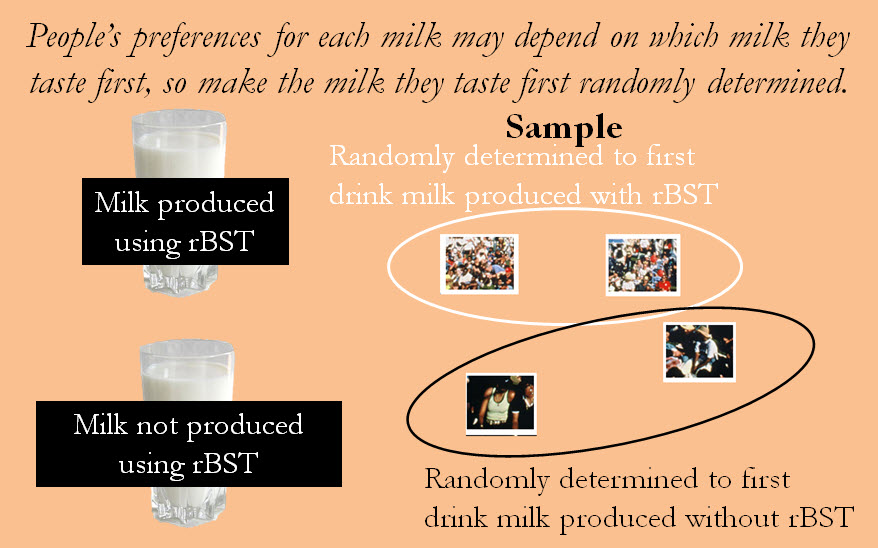

Dairy products, surveys, and consumer experiments (part 1)
It seems plausible that milk sold with a label indicating the farmers pledge not use the rBST hormone (or any synthetic growth hormone) would stigmatize milk sold without the pledge. If rBST did not compromise the milk in some way, why would producers pledge not to use it? That is probably what consumers are thinking, but to really determine whether this is the case, we need to collect data on consumer behavior.
Figure 1—Example of a milk label

Suppose we want to know how the presence of milk with the pledge affects consumers’s value for milk without the pledge. Our hypothesis is that the value of milk without the pledge declines when it is juxtaposed with milk containing the pledge, but we want to test this hypothesis using scientific methods.
Sometimes data on grocery store purchases can be used, but often they are unsuited to the task. When good data on actual consumer purchases in the grocery store are not available, agricultural economists tend to turn to experiments and surveys instead, where the setting, products, information, and prices can be controlled. The next three lectures are devoted to understanding the general methods in implementing one of these experiments, and studying a real consumer experiment comparing milk with and without the rBST pledge.
Although the discussion focuses on an experiment, where consumers are gathered in person where they taste and evaluate foods, the general methods apply to surveys as well.
What is “value”?

When economists use the word “value” they are referring to a very specific measure: the maximum amount of money a person will pay for an item. If a consumer tells us that they will pay up to $2.00 for a quart of organic milk, this means they will always buy it when the price is less than $2.00 (so the consumers must actually have at least $2.00 to pay for it) and will never buy it when the price is more than $2.00. In his novel The Picture of Dorian Gray one of Oscar Wilde’s characters referred to a man who, “knew the price of everything and the value of nothing.” Economists know exactly what the value is to a person, so long as they can observe their behavior when confronted with different prices. For instance, if a person buys one quart of milk when the price is $1.00 but buys none with the price is greater than $2.00, the economist knows that the person values one quart of milk more than $1.00 but less than $2.00. By using sophisticated auctions like that described in the next lecture, the economist can identify the person’s value precisely.
Implementing one of these auctions to measure the value of a good requires an experiment where you recruit people to participate in the auction and record their behavior. The goal of the auction is not to make money but measure how much people value different goods, and so the experiment must be designed to reveal this value. The design of such an experiment follows a number of important steps, described below.
Step 1: recruit a representative sample of subjects
The goal in recruiting subjects is to acquire a sample of individuals that are representative of the population you are studying. If we want to know the value of milk to Americans, then we want the demographic profile of the sample to mimic that of the nation. For instance, males and females are roughly half of the population each, so it would be nice if the sample contained an equal number of males and females. About 18% of the U.S. population resides in the Northeast part of the country, so the sample of Northeasterners would preferable be 18% also.
If your population of interest were instead college students, you would not want to sample people who are not in college, but you would want the demographics of your sample to match the demographic profile of college students overall.
Figure 2—Representative sample

Alas, no study ever achieves a perfectly representative sample. Most of the time, the expense of doing so is not worth the data one collects. Researchers just do the best they can with the budget they have, knowing there are some statistical tricks that can make the sample seem more representative than it really is (discussed in the second lecture after this one).
Once I conducted a telephone survey to study the attitudes of the American public towards farm animal welfare issues, and the figure below shows the composition of my sample relative to the American public. It was an imperfect sample, containing less males and more females than the American public, and more college graduates as well. Nevertheless, it was a good sample—good enough to be published in the scientific journal Animal Welfare.
Figure 3—An imperfect, but good sample(P1)

Even if the demographic profile of the sample and the nation corresponded perfectly, the sample still would not be perfectly representative, because people have to volunteer to participate, and not everyone will. The type of people who will and will not volunteer will differ in many ways, and you will never know if those who do not participate value milk differently. This is referred to as a self-selection bias, and it can be mitigated by paying people considerable sums of cash to participate. I once performed experiments in Illinois, North Carolina, and Texas where I paid people $75 to attend. The idea was that the prospect of earning $75 for one hour of participation will elicit people who would normally not volunteer. Some of those who would normally choose not to volunteer will be lured by $75, but not everyone, so it is a patch, not a fix.
Step 2: Control as much as you can
In the grocery store there are millions of factors that influence consumer behavior: the temperature, how crowded it is, the placement of different foods on the shelves, foods available at other stores, attractiveness of labels, etc.. In an experiment, you want to minimize these random influencers.
If the goal is to measure how the value of three milk types differ, make it such that very little other than the milk types change. If you want to know how the taste of regular, low-fat, and skim milk influences their value, let the consumer taste and then place a value on each milk type without knowing the type of milk they are tasting. If you want to observe how labels influence consumer preferences, you might want to put different labels on the same type of milk. Then, if people taste these milk products and prefer one over the other, you know it was the label—not the milk itself—that caused that difference in value. Don’t make one more inconvenient to reach, unless you want to measure how shopping behavior changes in response to differences in how foods are displayed. If this is the case, you might want to place the same good on different shelves to see which shelf elicits the most response.
Have the subjects evaluate and reveal their value for goods at the same time, not weeks apart, during which the consumer may have been influenced by new information. Don’t make a consumer pay money for one milk and then ask them how much they would pay for a second, as the fact that they have already purchased one milk will influence their willingness to purchase a second. Go to ridiculous extremes if you can. Don’t even allow a pretty girl to present one milk type and a less attractive girl present the other (unless you want to see how milk purchases change in the presence of less and more attractive people). If the experiments are conducted in different sessions, make sure you, the researcher, say the exact same thing to each group. This can be accomplished by reading off a script during every session, never adding or removing any part of the script. It is my experience that you should not allow subjects to talk amongst each other, as one person offering a specific opinion in one session may influence the behavior of everyone in that session. The whole purpose of doing a consumer experiment is to make it controlled, so let this be the one area of your life where you are more controlling than you ever thought imaginable!
Step 3: Randomize what you cannot control
There are always some things that will affect consumer behavior that the researcher cannot hold perfectly constant. For instance, in tasting and evaluating milk produced using and not using rBST, the consumer may be influenced by which milk product they taste first. For example, people might have a tendency to prefer the first (or perhaps the second) product they taste, regardless of which product it was. In this case, the researcher will want half of the subjects to taste the rBST milk first and half taste the non-rBST first. This way, in the overall results, if preferences are influenced by which product is tasted first, half of the subjects are influenced by tasting rBST first and half are influenced by tasting non-RBST first, leaving the results [largely] free of bias.
Figure 4—Randomize what you can’t control

Step 4: Use a Vickrey (or similar) auction
To be continued in the next lecture.